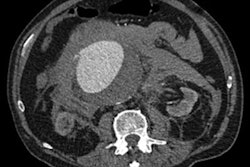
There are too few radiologists in the U.K., spread unevenly among geographic regions of the country. In this guest column, Dr. Nicola H. Strickland describes how implementing a regional National Health Service (NHS) teleradiology network could benefit the country's health system, its hospitals, its radiologists, and its patients.
There are too few radiologists working in the U.K., a problem that is exacerbated by uneven geographic distribution. Many district general radiologists' on-call rotations have become very onerous because of this shortage. This situation is expected to get worse rather than better, because a new government requirement is mandating 24/7 radiology coverage.
From a clinical standpoint, this is a realistic requirement. Almost all out-of-hours medical and surgical management decisions now require some form of radiological imaging or radiological intervention. Consultant radiologists are the medical specialists who should provide diagnostic interpretations.
Using teleradiology: In-sourced or contracted externally
But how will this need be met? Training more radiologists is the most obvious solution, but is unrealistic in view of the fact it requires more than five years of training for a physician to become a consultant radiologist. Making all specialists accessible through an NHS regional teleradiology network is a more viable alternative.
 Dr. Nicola H. Strickland, a consultant radiologist.
Dr. Nicola H. Strickland, a consultant radiologist.
All hospitals in the U.K. are currently linked together via an Image Exchange Portal (IEP). There are information governance agreements in place to allow for secure transmission and viewing of imaging studies and their reports between hospitals using the NHS network. The IEP was established by a private company, Burnbank, for the U.K. Department of Health to replace the use of DICOM CDs. RIS/PACS vendor Sectra subsequently purchased the portal.
Sectra has agreed to work with the NHS to set up, host, and manage in-sourced teleradiology networks. What is proposed is that imaging studies requiring urgent reporting and their associated requesting information (clinical information about the patient, relevant prior studies, etc.) will be sent via the IEP to regional archives. This information will be temporarily stored until retrieved by on-duty radiologists for immediate reporting.
The IEP can be securely accessed either over a NHS national network (N3) or a secure Internet connection. The teleradiology system would use a uniform DICOM diagnostic-quality viewer, and offer the ability to directly report the imaging studies. Out-of-hours reports prepared by a remote U.K. radiologist would be sent to the IEP and automatically integrated into the RIS/PACS of the originating hospital.
An alternative option is for each NHS Trust to contract with overseas teleradiology service providers. The problem with this is that while each individual trust is responsible for the standard of service provided by a teleradiology company, no rules exist as to how this should be done. There are no tests of professional competence required or proof of fluency in the English language.
There is also no case law illustrating what, if anything, would happen if an overseas teleradiologist provides an inaccurate report or inadequate service. There is no way to determine if that individual is under legal investigation for malpractice. If a serious reporting error would be made by a teleradiologist on a British patient, there is no requirement for prosecution in a British court or via the British legal system.
Advantages of an in-sourced NHS regional teleradiology network
In addition to using only radiologists employed by the NHS, there are many advantages of instituting in-sourced reporting networks. First, this could be implemented rapidly. The service would cost the NHS less than the cost of contracts implemented by individual trusts with private teleradiology companies. Rigorous, nationally approved information governance agreements that were set up for the IEP are already in place and in use.
The trusts could be assured a high quality reporting service by credentialed consultant radiologists who are familiar with NHS trusts, local clinical working practices, and their clinicians. The radiologists making teleradiology interpretations will be accessible to physicians from the originating hospital where the radiology exams were performed. Quality assurance and peer-reviewed procedures will be feasible.
Such access to and accountability of regional NHS radiologists who provide teleradiology interpretations and reports to local referring physician should foster trust by the referring physicians. Their medical consultations may be considered more valuable than that of an unknown private teleradiologist because in-network teleradiologists will be held accountable for the quality and accuracy of their work. And although remote, they can be part of a local clinical team.
Having an in-sourced regional network should reduce the work overload, lack of sleep from being on call, and improve the morale of district general hospital radiologists.
Finally, patient records will be more secure. It is noteworthy the private teleradiology companies currently working in the U.K. have been given free access to the entire radiology information system databases of the hospital trusts for whom they are providing a paid service. What this means is employees of the teleradiology companies, whether radiologists or administrators, have unrestricted access to the personal records of any patient on a database.
About the regional networks
Regions could be defined by extant geographical patient referral patterns and multidisciplinary team meeting clusters. This offers the advantage that on-call radiologists reporting on out-of-hours imaging are likely already to be known to the local nonradiological clinicians. For this reason, their reports would probably be more readily trusted by these clinicians.
Additionally, local teleradiologists are likely to be familiar with imaging protocols and clinical practice within their region. They may already be taking part in regional multidisciplinary team meetings, or could do so more easily. Such meetings facilitate clinical feedback and cement their relationship with the local referring clinicians.
On call rotation could be organized in a similar way that is currently being run by general practitioners. It could be on an "opt in" basis, available as an option for trusts to use if they wish rather than being compulsory.
Participating radiologists could get additional income for providing after-hours teleradiology services. The fee structure would be less than that currently charged by private teleradiology companies. So trusts would financially benefit by reducing outsourced teleradiology costs.
Workload and working environment improvements
The major incentive for radiologists to participate in a NHS regional in-sourcing on-call teleradiology network would be a major improvement in personal and professional lifestyle. Currently, many district general radiologists have on-call duty every one in five or six nights. They work a full NHS day before and after their on-call night.
It is common for these on-call radiologists to have to deal with three or four CT scans per night and often more. Even if the consultant radiologist on call is able to view and report the imaging study at his/her home, the consultant may be awake the entire night, spending time to discuss the need for the scan and the clinical presentation, to arrange for it to be done, to view the images, to issue a definitive report, and to very often discuss the findings with the referring physician. By morning, they are fatigued. But then they must work a full day at the hospital.
In contrast, a NHS regional in-sourcing on-call network would mean these radiologists would be on call much less frequently, perhaps only once every two months. Dates of service would be known well in advance and radiology departments would be able to schedule a day to rest following an on-call evening.
Other network uses
In addition to teleradiology, it might be possible to clear backlogs of unreported imaging studies, typically x-ray exams that exist in excessively overworked radiology departments.
The network could be used to improve the process of obtaining a second opinion from expert specialists. There are few specialist consultants in pediatric radiology in the country. Some trusts do not have enough consultant radiologists specializing in neurological, musculoskeletal, cardiac, or gynecological imaging. Right now, dedicated specialist radiologists are giving expert opinions on difficult outside referrals voluntarily. They are not getting paid for this service, nor is there any monitoring of how such requests for second opinions may be impacting their own workload.
The network could provide a mechanism for implementing double report audits in a fair and equitable manner. The selection, distribution, and management of anonymized reports could be handled through the network, with double reading provided by radiologists from different NHS trusts within a region.
Conclusion
The reasons to implement an in-sourced teleradiology network to better utilize the radiology professional resources of the U.K. are far greater than reasons not to implement it. In doing so, it would also offer an example to the world to replicate. The U.K. is not the only country in the world with a shortage of consultant radiologists.
Dr. Nicola H. Strickland is a consultant radiologist at Imperial College Healthcare NHS Trust -- London.
The comments and observations expressed herein do not necessarily reflect the opinions of AuntMinnieEurope.com, nor should they be construed as an endorsement or admonishment of any particular vendor, analyst, industry consultant, or consulting group.



















